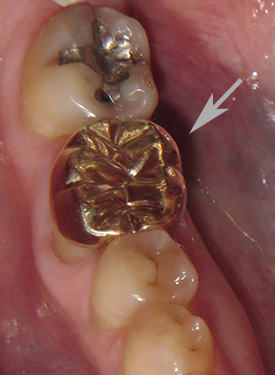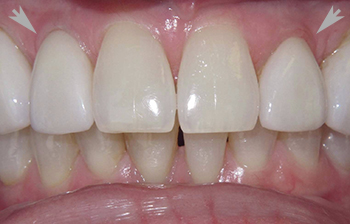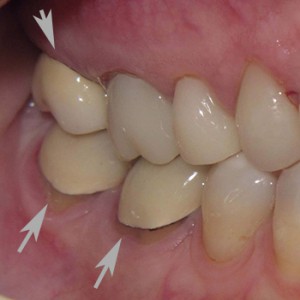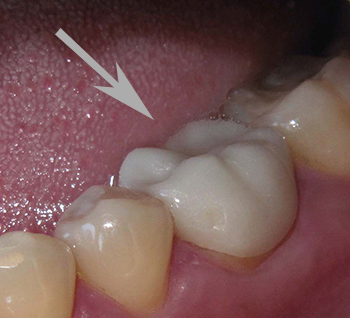Dentistry now offers more choices than ever before when it comes to restorative materials for teeth. Improvements in the beauty, strength, and durability of materials like porcelain and zirconium have made cosmetic restorations more natural and lifelike than some of the best materials in use just 10 or 15 years ago. But not every tooth or patient is best served with a full porcelain restoration. There are still many reasons that another material like gold or even composite might be a better choice for you. Let’s review the pros and cons of the most current materials available for crown and bridge restorations.
Gold

Gold has been used for a long time in dentistry, and for good reason. Gold is extremely durable and has the least reactivity of all the metals in the mouth. It is also extremely gentle on the opposing teeth and is especially well-suited for molars in patients who clench or grind habitually. Gold remains strong and durable even when it is thin, allowing for more conservative crown preparations and the preservation of more healthy tooth structure. Additionally, gold works beautifully with glass ionomer cements that are often far less sensitive for many patients than the bonding techniques required for full-porcelain crowns.
However, even with all the advantages that gold provides, it is not always the best choice for every tooth or individual patient.
Certainly, from a cosmetic standpoint, most patients would prefer not to use gold to restore a front tooth. Gold may also be the least reactive metal of all the metals used in dental restorations, but some patients can still be sensitive to a gold crown even if they do not have a specific gold allergy. All gold restorations are alloys, meaning that the gold is mixed with other metals to give it added strength. Pure gold would simply be too soft to be usable in the mouth. The best gold restorations are a high-noble alloy, meaning that at least 60% of the crown is made up of gold and other precious metals like platinum, palladium, and silver that are noted for their low-reactivity with human tissue and resistance to corrosion and oxidation.
Non-precious metal restorations are also available in some dental offices and they are less expensive in the short term. However, patients are far more likely to demonstrate an allergy or sensitivity to these materials, requiring removal and replacement much sooner than a high-noble gold restoration generally would.
Another drawback of any metal restoration, including gold, is that all metals conduct hot and cold quickly and efficiently. Patients with gold restorations often experience some sensitivity to hot and cold food or drinks during the first several weeks after placement of the crown. In general, this sensitivity subsides over time, but patients whose teeth are already extremely sensitive to hot and cold may want to consider other options.
Benefits of gold
Extremely durable and long-lasting
Gentle on opposing teeth
Strong even when thin, allowing for more conservative tooth preparation and the preservation of more healthy tooth structure
Cementation process is less sensitive for many patients than porcelain bonding techniques
Best for:
Back teeth where cosmetic concerns are lower; patients with habitual clenching and grinding habits.
Potential drawbacks of gold
Conducts hot and cold temperatures quickly, resulting in some initial sensitivity for a few weeks after placement
May be reactive to some patients with specific metal sensitivities (testing is available)
Visibly different from natural teeth
Gold can wear away over a period of years, especially when placed opposite a full porcelain crown or in patients who clench and grind heavily
Gold is cast like jewelry from molten metal which can sometimes leave micro-gaps at the margins which are more vulnerable to decay
May not be suitable for:
Patients with specific metal allergies or sensitivities (testing is available); front teeth; patients with extreme sensitivities to hot and cold.
Full Porcelain

For many years, full porcelain restorations have been considered the most lifelike and natural looking restorations available. They are extremely beautiful and the best choice for the ultimate cosmetic result. Porcelain also does not conduct heat and cold very efficiently, so sensitivity to hot and cold foods during the initial placement period is often reduced. However, full porcelain crowns are not always the best choice for every tooth in the mouth. Here’s why:
Porcelain has the unique combination of being both strong and weak at the same time, much like an eggshell. Porcelain is harder than tooth enamel, so it can be damaging to the opposing natural teeth especially in patients who clench and grind habitually. But porcelain can also be brittle and fracture easily when it is too thin or it is habitually flexed through the forces imposed by clenching and grinding.
In order to guard against fractures related to thinness, a full porcelain crown must be thicker all around than a gold restoration. This means that more healthy tooth structure may need to be removed to allow for the porcelain to be thick enough for overall strength and durability. Additionally, full porcelain must be bonded to the teeth differently than a gold restoration. Glass ionomer cements cannot be used. Some patients are more sensitive to these bonding procedures than others, and can experience extended tooth sensitivity during the initial placement period.
Benefits of full porcelain
Produces the most beautiful and lifelike cosmetic result
Does not conduct heat or cold well, reducing temperature sensitivity
Non-reactive in patients with metal sensitivities
Best for:
Front teeth and any other tooth where an exquisite cosmetic result is the primary concern.
Potential drawbacks of full porcelain
Fractures more easily than other materials
More tooth structure must be removed than would be necessary for a gold crown
Can be damaging to opposing teeth
May not be not suitable for:
Molar restorations in patients who clench and grind; patients with sensitivities to specific bonding techniques and materials (testing is available); patients who do not have enough healthy tooth structure available to support the thickness of a porcelain restoration.
Porcelain Fused To Gold

Until some of the more recent developments in the use of zirconium as a base for porcelain dental restorations, porcelain fused to gold crowns offered the best compromise between the strength and durability of gold and the cosmetic benefits of porcelain.
A porcelain fused to gold crown is made exactly as it sounds like it might be – porcelain is fused and stacked in layers on top of a high-noble gold alloy base. The porcelain offers a much better cosmetic result than a full gold crown, and the gold base not only allows for the use of glass-ionomer cements, but also acts as a protective barrier for the tooth even if the porcelain might fracture. But porcelain fused to gold crowns are not nearly as popular as they used to be.
One reason is because the gold base creates an automatic opacity in the porcelain that looks less lifelike in the mouth than full porcelain or porcelain fused to other materials like zirconium. Also, when used on the front teeth, a porcelain fused to gold crown can sometimes show a dark metal edge at the gumline when recession occurs. And certainly for any patient with metal allergies or sensitivities, any crown that contains a metal alloy base may not be a suitable choice.
Porcelain fused to gold crowns are still available, however, and they are still a useful option – especially for patients who may have several of these crowns already and are looking to match their existing dental work.
Benefits of porcelain fused to gold
Stronger and more durable than full porcelain
Better cosmetic option than full gold
Allows for the use of glass ionomer cements that are often less sensitive than full porcelain bonding techniques
Gold base still protects the tooth, even if some of the porcelain fractures off
Best for:
Patients who already have several porcelain fused to gold crowns and want to match them; patients who may not be good candidates for an all porcelain crown or a porcelain fused to zirconium crown, but still want a better cosmetic result than a full gold crown.
Potential drawbacks of porcelain fused to gold
Opacity caused by metal base makes porcelain look less lifelike
Dark metal edge is sometimes visible at the gumline
Porcelain may fracture off the metal base
Gold is cast like jewelry from molten metal which can sometimes leave micro-gaps at the margins which are more vulnerable to decay
May not be suitable for:
Patients with specific metal allergies or sensitivities (testing is available); front teeth; back teeth in patients who clench and grind.
Porcelain Fused To Zirconia And Full Zirconia

Zirconia, or zirconium dioxide, is a white crystalline oxide made from the metal zirconium. In its cubic form, it creates the simulated diamond-like stone we all know as cubic zirconia. But zirconia has also been used and studied for many years in the production of all kinds of ceramics, including dental restorations.
Zirconia is an ideal base for porcelain because the bonding process between the zirconia and the porcelain is stronger than it is with porcelain and gold. This means that the porcelain is less likely to fracture away from a zirconia base. Zirconia can also be colored to match teeth and it is translucent, mimicking the natural look of teeth far better than any crown with a gold base could.
Zirconia at its core is still derived from metal, however, and that comes with some advantages and disadvantages. Glass ionomer cements work extremely well with Zirconia based crowns, which is often a benefit for patients who are sensitive to porcelain bonding techniques. However, even though zirconia is almost never reactive as a metal in the mouth, some patients with extreme metal sensitivities may want to be tested for reactivity before placing a permanent zirconia restoration.
Benefits of zirconia
As strong and durable as gold, but translucent with a better cosmetic result
Allows for the use of glass ionomer cements that are often less sensitive than full porcelain bonding techniques
Full zirconia is stronger than porcelain, although not quite as cosmetically attractive
Porcelain fused to zirconia is less likely to fracture than porcelain fused to gold
Crowns and bases are milled from digital scans making the margins extremely accurate
May be less expensive than gold or gold-based crowns
Best for:
Any full crown restoration where a beautiful cosmetic result is desired, but extra strength and durability are required.
Potential drawbacks of zirconia
Not suitable as veneers or other partial tooth restorations
May be reactive for some patients with specific metal sensitivities (testing is available)
May not be suitable for:
Patients with specific metal allergies or sensitivities (testing is available).
Composite
Composite crowns are the least ideal in terms of strength and durability, but for some patients who are very sensitive to both metals and porcelain, composite crowns can offer the next best solution for restoration.
Dental composite is a synthetic resin material that is most used for tooth-colored fillings. However, dental composite can also be used to make relatively strong crowns when it is cured and processed into blocks outside of the mouth and then milled to fit using CAD/CAM techniques like CEREC. Composite is not as durable as gold or porcelain and does need to be replaced more often, but for patients who cannot tolerate any other materials currently in use, composite can be a very useful alternative.
Benefits of dental composite
Softer than porcelain and less reactive than gold or other metals
Bonding techniques are less sensitive than full porcelain bonding
Good for use as long-term temporaries or as an interim option for patients with a high decay rate
Usually less expensive than crowns made from gold, porcelain, or zirconia
Best for:
Patients with extreme metal sensitivities who are also unable to tolerate full porcelain.
Potential drawbacks of dental composite
Weakest restorative material for crowns
Requires replacement more regularly than any other crown material
May not be suitable for:
Any patient who can tolerate other more durable materials used in crown fabrication.

 English
English